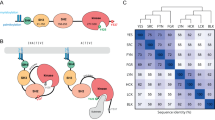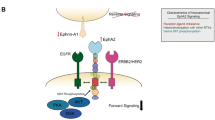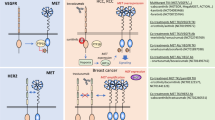Abstract
Trastuzumab is a successful rationally designed ERBB2-targeted therapy. However, about half of individuals with ERBB2-overexpressing breast cancer do not respond to trastuzumab-based therapies, owing to various resistance mechanisms. Clinically applicable regimens for overcoming trastuzumab resistance of different mechanisms are not yet available. We show that the nonreceptor tyrosine kinase c-SRC (SRC) is a key modulator of trastuzumab response and a common node downstream of multiple trastuzumab resistance pathways. We find that SRC is activated in both acquired and de novo trastuzumab-resistant cells and uncover a novel mechanism of SRC regulation involving dephosphorylation by PTEN. Increased SRC activation conferred considerable trastuzumab resistance in breast cancer cells and correlated with trastuzumab resistance in patients. Targeting SRC in combination with trastuzumab sensitized multiple lines of trastuzumab-resistant cells to trastuzumab and eliminated trastuzumab-resistant tumors in vivo, suggesting the potential clinical application of this strategy to overcome trastuzumab resistance.
This is a preview of subscription content, access via your institution
Access options
Subscribe to this journal
Receive 12 print issues and online access
$209.00 per year
only $17.42 per issue
Buy this article
- Purchase on Springer Link
- Instant access to full article PDF
Prices may be subject to local taxes which are calculated during checkout






Similar content being viewed by others
References
Slamon, D.J. et al. Use of chemotherapy plus a monoclonal antibody against HER2 for metastatic breast cancer that overexpresses HER2. N. Engl. J. Med. 344, 783–792 (2001).
Romond, E.H. et al. Trastuzumab plus adjuvant chemotherapy for operable HER2-positive breast cancer. N. Engl. J. Med. 353, 1673–1684 (2005).
Vogel, C.L. et al. Efficacy and safety of trastuzumab as a single agent in first-line treatment of HER2-overexpressing metastatic breast cancer. J. Clin. Oncol. 20, 719–726 (2002).
Seidman, A.D. et al. Randomized phase III trial of weekly compared with every-3-weeks paclitaxel for metastatic breast cancer, with trastuzumab for all HER-2 overexpressors and random assignment to trastuzumab or not in HER-2 nonoverexpressors: final results of Cancer and Leukemia Group B protocol 9840. J. Clin. Oncol. 26, 1642–1649 (2008).
Lan, K.H., Lu, C.H. & Yu, D. Mechanisms of trastuzumab resistance and their clinical implications. Ann. NY Acad. Sci. 1059, 70–75 (2005).
Piccart, M. Circumventing de novo and acquired resistance to trastuzumab: new hope for the care of ErbB2-positive breast cancer. Clin. Breast Cancer 8 (Suppl 3), S100–S113 (2008).
Nagata, Y. et al. PTEN activation contributes to tumor inhibition by trastuzumab, and loss of PTEN predicts trastuzumab resistance in patients. Cancer Cell 6, 117–127 (2004).
Berns, K. et al. A functional genetic approach identifies the PI3K pathway as a major determinant of trastuzumab resistance in breast cancer. Cancer Cell 12, 395–402 (2007).
Scaltriti, M. et al. Expression of p95HER2, a truncated form of the HER2 receptor, and response to anti-HER2 therapies in breast cancer. J. Natl. Cancer Inst. 99, 628–638 (2007).
Moulder, S.L. et al. Epidermal growth factor receptor (HER1) tyrosine kinase inhibitor ZD1839 (Iressa) inhibits HER2/neu (erbB2)-overexpressing breast cancer cells in vitro and in vivo. Cancer Res. 61, 8887–8895 (2001).
Dua, R. et al. EGFR over-expression and activation in high HER2, ER negative breast cancer cell line induces trastuzumab resistance. Breast Cancer Res. Treat. 122, 685–697 (2009).
Ritter, C.A. et al. Human breast cancer cells selected for resistance to trastuzumab in vivo overexpress epidermal growth factor receptor and ErbB ligands and remain dependent on the ErbB receptor network. Clin. Cancer Res. 13, 4909–4919 (2007).
Lu, Y., Zi, X., Zhao, Y., Mascarenhas, D. & Pollak, M. Insulin-like growth factor-I receptor signaling and resistance to trastuzumab (Herceptin). J. Natl. Cancer Inst. 93, 1852–1857 (2001).
Nahta, R., Yuan, L.X., Zhang, B., Kobayashi, R. & Esteva, F.J. Insulin-like growth factor-I receptor/human epidermal growth factor receptor 2 heterodimerization contributes to trastuzumab resistance of breast cancer cells. Cancer Res. 65, 11118–11128 (2005).
Shattuck, D.L., Miller, J.K., Carraway, K.L. III & Sweeney, C. Met receptor contributes to trastuzumab resistance of Her2-overexpressing breast cancer cells. Cancer Res. 68, 1471–1477 (2008).
Huang, X. et al. Heterotrimerization of the growth factor receptors erbB2, erbB3, and insulin-like growth factor-I receptor in breast cancer cells resistant to herceptin. Cancer Res. 70, 1204–1214 (2010).
Narayan, M. et al. Trastuzumab-induced HER reprogramming in “resistant” breast carcinoma cells. Cancer Res. 69, 2191–2194 (2009).
Zhang, S. & Yu, D. PI(3)king apart PTEN′s role in cancer. Clin. Cancer Res. 16, 4325–4330 (2010).
Liaw, D. et al. Germline mutations of the PTEN gene in Cowden disease, an inherited breast and thyroid cancer syndrome. Nat. Genet. 16, 64–67 (1997).
Kmiecik, T.E. & Shalloway, D. Activation and suppression of pp60c-src transforming ability by mutation of its primary sites of tyrosine phosphorylation. Cell 49, 65–73 (1987).
Tice, D.A., Biscardi, J.S., Nickles, A.L. & Parsons, S.J. Mechanism of biological synergy between cellular Src and epidermal growth factor receptor. Proc. Natl. Acad. Sci. USA 96, 1415–1420 (1999).
Ishizawar, R. & Parsons, S.J. c-Src and cooperating partners in human cancer. Cancer Cell 6, 209–214 (2004).
Baselga, J. & Swain, S.M. Novel anticancer targets: revisiting ERBB2 and discovering ERBB3. Nat. Rev. Cancer 9, 463–475 (2009).
Junttila, T.T. et al. Ligand-independent HER2/HER3/PI3K complex is disrupted by trastuzumab and is effectively inhibited by the PI3K inhibitor GDC-0941. Cancer Cell 15, 429–440 (2009).
Tabernero, J. et al. Phase I study of AZD0530, an oral potent inhibitor of Src kinase: First demonstration of inhibition of Src activity in human cancers. in ASCO Meeting Vol. 25, 3520 (2007).
Reagan-Shaw, S., Nihal, M. & Ahmad, N. Dose translation from animal to human studies revisited. FASEB J. 22, 659–661 (2008).
Stommel, J.M. et al. Coactivation of receptor tyrosine kinases affects the response of tumor cells to targeted therapies. Science 318, 287–290 (2007).
Tol, J. et al. Chemotherapy, bevacizumab, and cetuximab in metastatic colorectal cancer. N. Engl. J. Med. 360, 563–572 (2009).
Bromann, P.A., Korkaya, H. & Courtneidge, S.A. The interplay between Src family kinases and receptor tyrosine kinases. Oncogene 23, 7957–7968 (2004).
Parsons, J.T. & Parsons, S.J. Src family protein tyrosine kinases: cooperating with growth factor and adhesion signaling pathways. Curr. Opin. Cell Biol. 9, 187–192 (1997).
Biscardi, J.S. et al. c-Src-mediated phosphorylation of the epidermal growth factor receptor on Tyr845 and Tyr1101 is associated with modulation of receptor function. J. Biol. Chem. 274, 8335–8343 (1999).
Karni, R., Jove, R. & Levitzki, A. Inhibition of pp60c-Src reduces Bcl-XL expression and reverses the transformed phenotype of cells overexpressing EGF and HER-2 receptors. Oncogene 18, 4654–4662 (1999).
Belsches-Jablonski, A.P. et al. Src family kinases and HER2 interactions in human breast cancer cell growth and survival. Oncogene 20, 1465–1475 (2001).
Ishizawar, R.C., Miyake, T. & Parsons, S.J. c-Src modulates ErbB2 and ErbB3 heterocomplex formation and function. Oncogene 26, 3503–3510 (2007).
Nautiyal, J. et al. ErbB-inhibitory protein: a modified ectodomain of epidermal growth factor receptor synergizes with dasatinib to inhibit growth of breast cancer cells. Mol. Cancer Ther. 9, 1503–1514 (2010).
Wang, S.E. et al. Transforming growth factor beta induces clustering of HER2 and integrins by activating Src-focal adhesion kinase and receptor association to the cytoskeleton. Cancer Res. 69, 475–482 (2009).
Seoane, S., Montero, J.C., Ocana, A. & Pandiella, A. Effect of multikinase inhibitors on caspase-independent cell death and DNA damage in HER2-overexpressing breast cancer cells. J. Natl. Cancer Inst. 102, 1432–1446 (2010).
Lu, C.H. et al. Preclinical testing of clinically applicable strategies for overcoming trastuzumab resistance caused by PTEN deficiency. Clin. Cancer Res. 13, 5883–5888 (2007).
LoPiccolo, J., Blumenthal, G.M., Bernstein, W.B. & Dennis, P.A. Targeting the PI3K/AKT/mTOR pathway: effective combinations and clinical considerations. Drug Resist. Updat. 11, 32–50 (2008).
Johnson, D. et al. Regulation of both apoptosis and cell survival by the v-Src oncoprotein. Cell Death Differ. 7, 685–696 (2000).
Webb, D.J. et al. FAK-Src signalling through paxillin, ERK and MLCK regulates adhesion disassembly. Nat. Cell Biol. 6, 154–161 (2004).
Ren, Z. & Schaefer, T.S. ErbB-2 activates Stat3α in a Src- and JAK2-dependent manner. J. Biol. Chem. 277, 38486–38493 (2002).
Kennedy, S.G. et al. The PI 3-kinase/Akt signaling pathway delivers an anti-apoptotic signal. Genes Dev. 11, 701–713 (1997).
Olayioye, M.A., Badache, A., Daly, J.M. & Hynes, N.E. An essential role for Src kinase in ErbB receptor signaling through the MAPK pathway. Exp. Cell Res. 267, 81–87 (2001).
Tan, M., Li, P., Sun, M., Yin, G. & Yu, D. Upregulation and activation of PKC alpha by ErbB2 through Src promotes breast cancer cell invasion that can be blocked by combined treatment with PKCα and Src inhibitors. Oncogene 25, 3286–3295 (2006).
Bowman, T. et al. Stat3-mediated Myc expression is required for Src transformation and PDGF-induced mitogenesis. Proc. Natl. Acad. Sci. USA 98, 7319–7324 (2001).
Franke, T.F., Hornik, C.P., Segev, L., Shostak, G.A. & Sugimoto, C. PI3K/Akt and apoptosis: size matters. Oncogene 22, 8983–8998 (2003).
Chang, F. et al. Regulation of cell cycle progression and apoptosis by the Ras/Raf/MEK/ERK pathway. Int. J. Oncol. (Review) 22, 469–480 (2003).
Al Zaid Siddiquee, K. & Turkson, J. STAT3 as a target for inducing apoptosis in solid and hematological tumors. Cell Res. 18, 254–267 (2008).
Zhang, X.H. et al. Latent bone metastasis in breast cancer tied to Src-dependent survival signals. Cancer Cell 16, 67–78 (2009).
Boyer, B., Bourgeois, Y. & Poupon, M.F. Src kinase contributes to the metastatic spread of carcinoma cells. Oncogene 21, 2347–2356 (2002).
Nahta, R., Takahashi, T., Ueno, N.T., Hung, M.C. & Esteva, F.J. P27kip1 down-regulation is associated with trastuzumab resistance in breast cancer cells. Cancer Res. 64, 3981–3986 (2004).
Lee, G.Y., Kenny, P.A., Lee, E.H. & Bissell, M.J. Three-dimensional culture models of normal and malignant breast epithelial cells. Nat. Methods 4, 359–365 (2007).
Acknowledgements
We thank AstraZeneca for providing us with saracatinib and W. Zhang in the Department of Pathology, MD Anderson Cancer Center for providing us with the IGF-1R expression vector. We also thank C. Neal, J. Lu, S. Rehman and F.J. Lowery for insightful comments on this manuscript. This work was supported by US National Institutes of Health grants P30-CA 16672 (MD Anderson Cancer Center), RO1-CA112567 (D.Y.), PO1-CA099031 project 4 (D.Y.), MD Anderson Cancer Center Breast SPORE P50 CA116199 (G.N.H.) project 4 (D.Y.), US Department of Defense Center of Excellence subproject W81XWH-06-2-0033 (D.Y.), Susan G. Komen Breast Cancer Foundation promise grant KG091020 (D.Y.), Cancer Prevention Research Institute of Texas grant RP100726 (D.Y.), the MD Anderson Cancer Center Breast SPORE Career Development Award (S.Z.) and the Susan G. Komen Breast Cancer Foundation postdoctoral fellowship (S.Z.). D.Y. is the Hubert L. and Olive Stringer Distinguished Chair in Basic Science at MD Anderson Cancer Center.
Author information
Authors and Affiliations
Contributions
S.Z., W.-C.H. and D.Y. designed experiments and analyzed data; S.Z., W.-C.H., H.G., P.L., S.-B.P., S.W.B., Y.X., L.-M.T. and Z.D. carried out experiments; S.Z., H.G. and S.-H.L. did statistical analysis of clinical data; A.A.S. collected tumor samples and evaluated immunohistochemistry staining with H.G.; G.N.H. and F.J.E. collected clinical patient information and analyzed patient response data; S.Z., S.W.B. and D.Y. wrote the manuscript.
Corresponding author
Ethics declarations
Competing interests
The authors declare no competing financial interests.
Supplementary information
Supplementary Text and Figures
Supplementary Figures 1–22, Supplementary Table 1 and Supplementary Methods (PDF 511 kb)
Rights and permissions
About this article
Cite this article
Zhang, S., Huang, WC., Li, P. et al. Combating trastuzumab resistance by targeting SRC, a common node downstream of multiple resistance pathways. Nat Med 17, 461–469 (2011). https://doi.org/10.1038/nm.2309
Received:
Accepted:
Published:
Issue Date:
DOI: https://doi.org/10.1038/nm.2309
This article is cited by
-
Trastuzumab-resistant breast cancer cells-derived tumor xenograft models exhibit distinct sensitivity to lapatinib treatment in vivo
Biological Procedures Online (2023)
-
SRC kinase-mediated signaling pathways and targeted therapies in breast cancer
Breast Cancer Research (2022)
-
The equilibrium of tumor suppression: DUBs as active regulators of PTEN
Experimental & Molecular Medicine (2022)
-
The phosphorylation and dephosphorylation switch of VCP/p97 regulates the architecture of centrosome and spindle
Cell Death & Differentiation (2022)
-
N6-methyladenosine regulated FGFR4 attenuates ferroptotic cell death in recalcitrant HER2-positive breast cancer
Nature Communications (2022)



